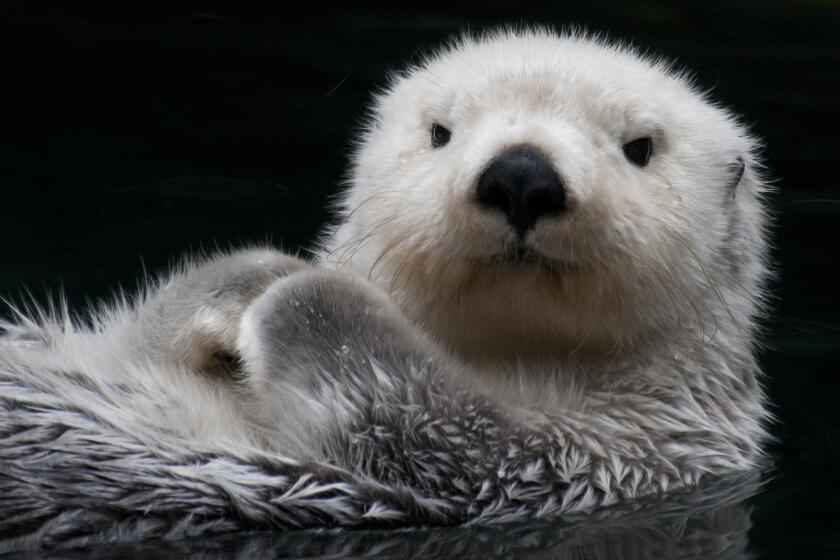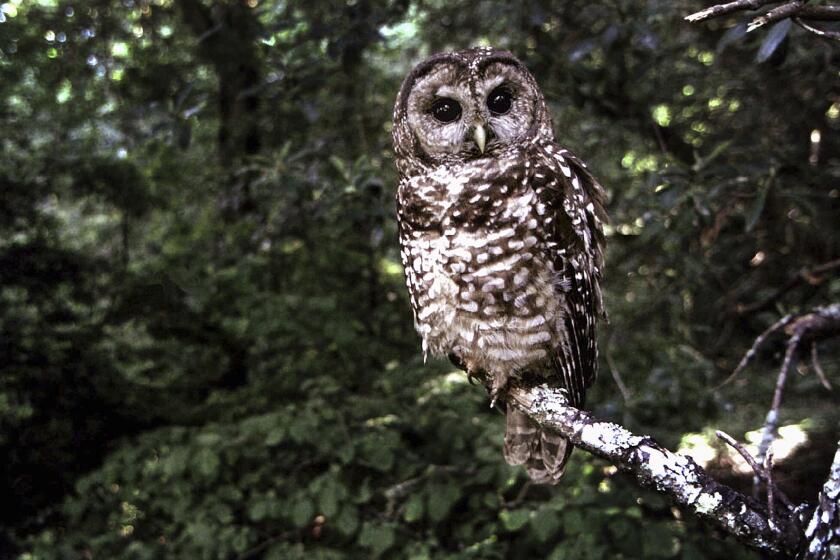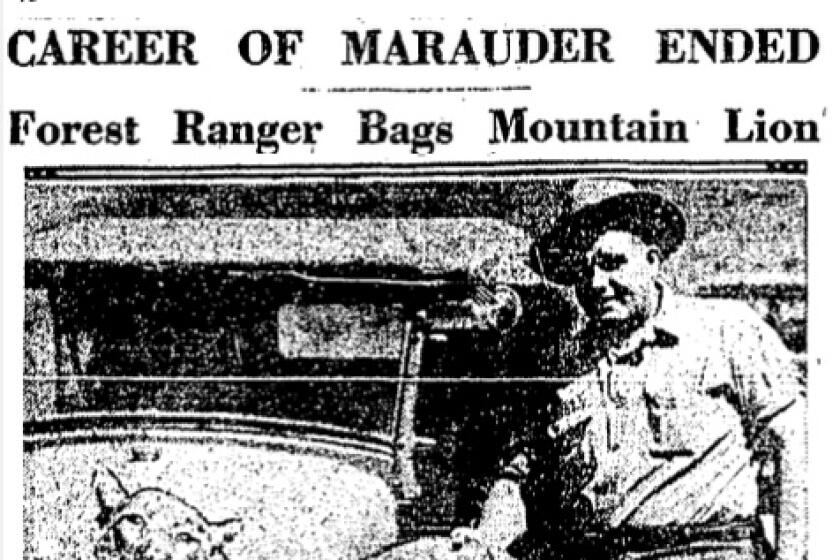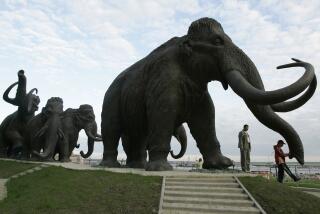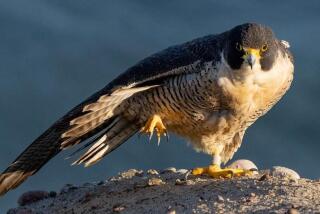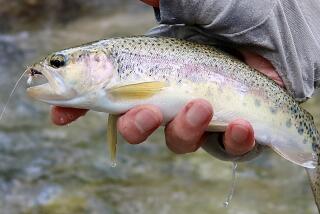As species recover, some threaten others in more dire shape
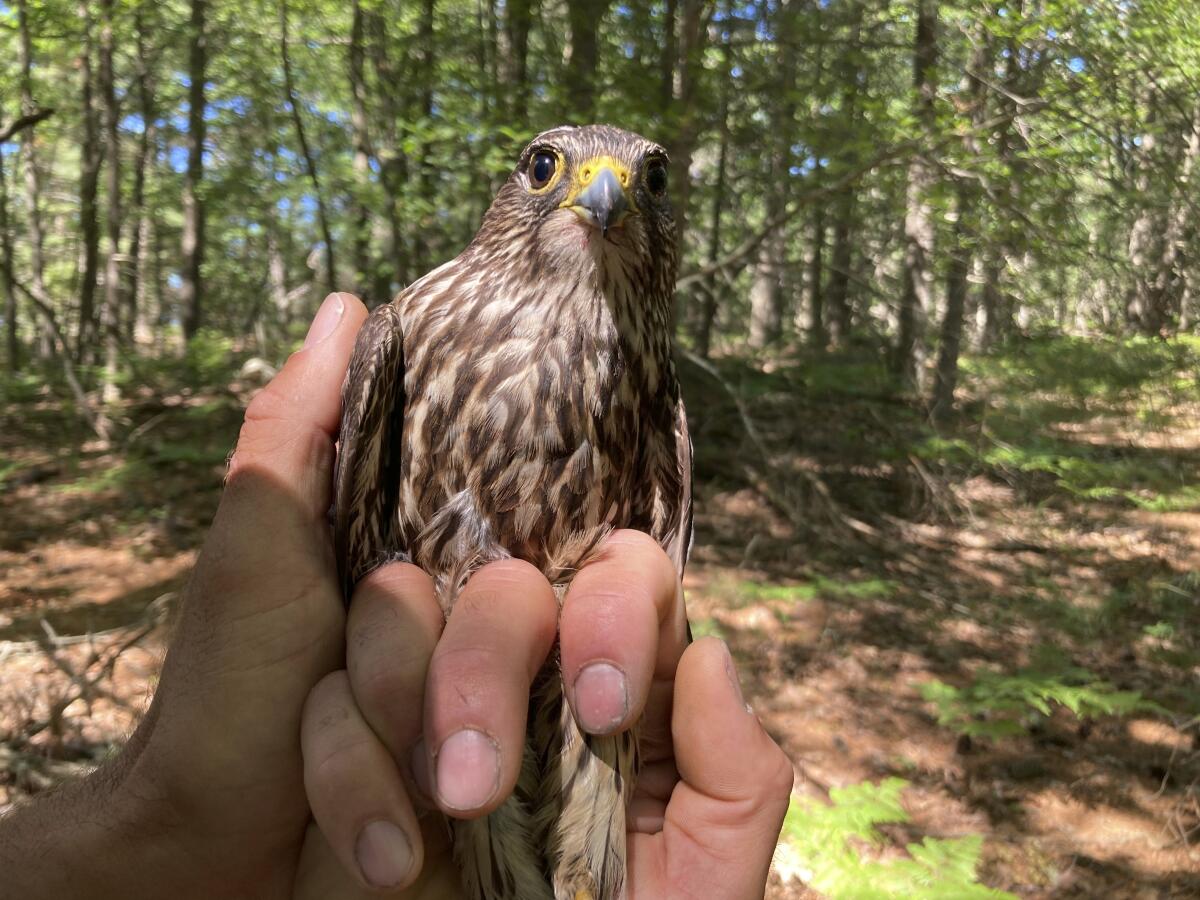
GLEN ARBOR, Mich. — Concealed behind trees near Lake Michigan, two scientists remotely manipulated a robotic owl on the forest floor. As the intruder flapped its wings and hooted, a merlin guarding its nest in a nearby pine darted overhead, sounding high-pitched, rapid-fire distress calls.
The small falcon dived toward the enemy — and into a net that Smithsonian interns Tim Baerwald and Zachary Bordner had stretched between steel poles. They gently disentangled the brownish-speckled merlin, then attached a leg band and a backpack transmission unit so researchers could trace the mother bird’s movements.
“As long as it’s fitted correctly, she’ll have a long and happy life,” Baerwald said before Bordner released the merlin, which zipped back to its nesting tree.
The mission will enhance knowledge of a species still recovering from a significant drop-off caused by pesticides including DDT, banned in 1972 after harming many birds of prey. It also is helping Sleeping Bear Dunes National Lakeshore managers protect the piping plover, an endangered shorebird that merlins kill and eat.
“Merlins are a big threat to their recovery,” said Nathan Cooper, a research ecologist with the Smithsonian’s National Zoo and Conservation Biology Institute.
The situation is ironic: A troubled species rebounds thanks to restoration efforts, only to make things worse for others in peril by preying on them or outcompeting them for food and living space. Similar circumstances have turned up elsewhere, challenging wildlife experts who want them all to thrive in balanced, healthy environments.
For instance, the iconic bald eagle’s comeback has pressured rare water birds. Resurgent peregrine falcons menace endangered California least terns and Western snowy plovers that take refuge at naval bases near San Diego. And off the California coast, attacks from protected white sharks hinder recovery of threatened sea otters.
Federal wildlife officials have taken the first step toward potentially reintroducing sea otters to their former habitats in Northern California and Oregon.
Gray seals previously on the brink of extirpation in waters off New England now occupy some Massachusetts beaches by the hundreds. The 800-pound mammal’s return has raised worries about vulnerable fish stocks.
Such unintended consequences don’t necessarily reveal flaws in the U.S. Endangered Species Act or conservation programs, experts say. Rather, they illustrate nature’s complexity and the importance of protecting biological communities, not just individual species.
“Clearly there are occasions when we get these conflicts between species that we’re trying to protect,” said Stuart Pimm, a Duke University extinction specialist. “But is it a major worry in conservation? No.”
Species recoveries can produce trade-offs, since some animals are more adaptable than others to changes in the climate or landscape, said Bruce Stein, chief scientist with the National Wildlife Federation.
“A lot of ecosystems where these things are occurring are a little out of whack to begin with because we’ve altered them in some way,” Stein said. “With climate change, there are going to be winners and losers. The losers will tend to have specific habitat requirements, narrow ecological niches, and often will be the ones already declining.”
The Great Lakes region has an estimated 65 to 70 pairs of sandy-backed, ring-necked piping plovers, which skitter along beaches nibbling tiny marine animals and eggs. They’re among three remaining North American populations, their decline caused primarily by habitat loss and predation.
A federal judge has thrown out a host of actions by the Trump administration to roll back protections for endangered or threatened species.
Meanwhile, merlin numbers in the region have jumped. In the last 10 to 15 years, they’re suspected of killing at least 57 adult plovers, Cooper said.
Though officials have shot some merlins, they’re looking for nonlethal controls. Data from the transmitter backpacks might help determine whether capturing and relocating them are worth trying, said Vince Cavalieri, a biologist with the national lakeshore.
Eagles threaten rare birds
Recovery of America’s national bird, the bald eagle, is a triumph. But in one area of coastal Maine, the big raptor poses a problem for the only U.S. breeding population of great cormorants.
“When they’re disturbed by eagles, the adult cormorants will flush and leave their nests,” said Don Lyons, a conservation scientist at the National Audubon Society’s Seabird Institute.
Then gulls, ravens and crows swoop in to gobble cormorant eggs and chicks. “If this happens repeatedly, an entire colony can fail,” Lyons said.
His team organizes volunteers to camp near cormorant gatherings to scare away eagles.
In Southern California, least terns and snowy plovers are no match for attacking peregrine falcons, which like eagles bounced back after the ban on DDT. Such pesticides are passed up food chains and cause large birds to produce eggs with thin shells, which females crush when trying to incubate them.
The state was essentially at war with cougars until the 1960s, when the bounties ended. As the big cats’ numbers declined, they came to enjoy more and more protections.
The San Diego Zoo and Wildlife Alliance tries to protect the endangered birds by hiring a falconer to capture problem peregrines, keeping them in a holding facility over the winter or releasing them in Northern California. Some find a new territory, while others go back, said Nacho Vilchis, a conservation ecologist.
“If there’s a real problem bird that keeps returning, we may ask for permission for lethal removal, but that’s only rarely done,” Vilchis said.
Hunting and bounties devastated New England’s gray seals. Saved by the Marine Mammal Protection Act of 1972, the population has rebounded to tens of thousands.
Fishing groups say the seals could threaten cod stocks that regulators are struggling to rebuild after decades of overfishing.
The Coastal Ecosystem Alliance, based in Fair-haven, Mass., wants to weaken the protection act to allow hunting and slow the seals’ population growth, said board member Peter Krogh.
“Gray seals are certainly this case where recovery has both been cause for celebration and cause for concern,” said Kristina Cammen, a University of Maine marine mammal scientist who says they’re less of a hazard to fish populations than humans are.
Seals, cormorants bedevil fishers
Like the clash over seals and cod, there are other cases where reviving species may be more a nuisance to people than a threat to other wildlife.
Fish farmers in the South and anglers in the Great Lakes region and Pacific Northwest have long complained about the double-crested cormorant, a dark-feathered diving bird that gorges on catfish, perch, salmon and other prized species.
Cormorants have done so well since the DDT ban that agencies have tried limiting them in some locations with egg oiling, nest destruction and even shooting — drawing lawsuits from environmentalists who say the birds are a scapegoat for human actions that harm fish.
“They’re a part of our avian community and our ecosystems, and there needs to be a place for them,” said Dave Fielder, a fisheries research biologist with the Michigan Department of Natural Resources. “But when their numbers are so high that they potentially decimate the recreational fishery, that’s a problem.”
Wild turkeys were spread across North America before European settlement but had dwindled to tens of thousands by the 1930s,
disappearing from many states. Now they’re hunted in 49 states and are so common in New England that they often cause traffic tie-ups.
Some hunters say hungry turkeys are outcompeting ruffed grouse, which are decreasing in parts of their range, such as the Upper Midwest. But scientists point to habitat loss and climate change.
The National Wild Turkey Federation is helping move turkeys from states with plenty — such as North Carolina, Maine and West Virginia — to Texas and others that could use more, said Mark Hatfield, national director of conservation services.
“If you introduce hunting localized wild turkeys, you reduce the problem with overabundant turkeys right away,” Hatfield said.
Nature at work
Conflicts between recovering species and ones still in trouble don’t always mean something is wrong, scientists say. It could reflect a return to how things were before humans got in the way.
“When a population gets back to where it’s having the same interactions with other organisms as before it went down, that’s nature at work,” said John Fitzpatrick, emeritus director of Cornell University’s Laboratory of Ornithology.
The bald eagle is “challenging our preconceived notions about what’s normal” for prey such as great cormorants in New England and common murres on the West Coast, which might have been less abundant before eagles declined, said Lyons of the Audubon Society.
The eagle’s recovery “complicates the conservation of certain other species,” Lyons said. “But their recovery is such a wonderful outcome ... that’s a welcome complication.”
Predator-prey relationships are complex and intervening can be tricky, said Stein of the wildlife federation. It’s often wiser, he said, to focus on protecting habitat and reconnecting fragmented landscapes to promote natural migration than “moving things around willy-nilly.”
But environmental scientist Ian Warkentin, a merlin specialist, said there can be ways to help struggling species without being heavy-handed.
Larger falcons — such as peregrines sometimes used to chase birds from airports — might be deployed to shoo merlins from plover nesting areas.
“I fall on the side of the fence that says we should do whatever we can ... to aid the recovery of species for which we’ve caused such grief,” said Warkentin, from Memorial University of Newfoundland’s Grenfell campus.
More to Read
Sign up for Essential California
The most important California stories and recommendations in your inbox every morning.
You may occasionally receive promotional content from the Los Angeles Times.
